投稿日:
更新日:
The ultimate figure of soybeans Nagano It was in the prefecture! ? "Frozen tofu" is hot right now!
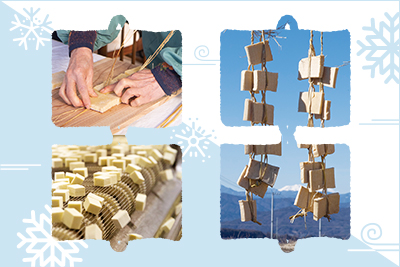
In the cold winter Nagano The prefecture has developed a unique food culture that makes use of the extremely cold climate and climate in various parts of the prefecture. In particular, in basins and mountainous areas where the temperature gets colder than the temperature drops below 10 degrees Celsius and humidity are low, a variety of processed foods have been produced using the "natural freeze-dried method" that has been repeatedly freeze-dried and dried, and has been useful as a preserved food. A typical example of this is frozen tofu. Traditional ingredients packed with the excellent nutritional value and deliciousness of soybeans are once again attracting a lot of attention as health foods rich in high-quality protein and minerals.
Combines deliciousness, nutrition and preservativeness Nagano The prefecture's proud traditional food
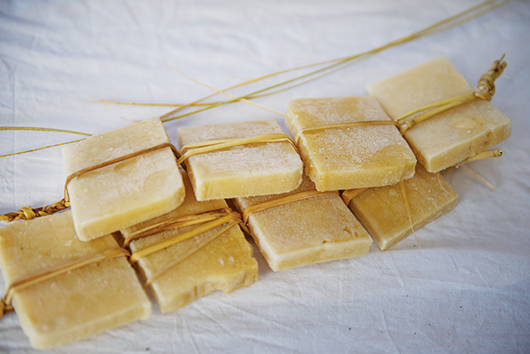
"Frozen tofu" is once again attracting attention as an ingredient rich in the resistant protein needed by modern people. This is a traditional food made by freeze-dried thinly sliced cotton tofu, and is also known as "Koya (Takaya) tofu" or "Frozen tofu."
Nagano Production is active in the prefecture, mainly in the Saku, Suwa and Iida regions. It is said that in the Saku region, it was made after Takeda Shingen liked to use it as a source of military supplies during the Warring States period, more than 400 years ago, and it is said that the manufacturing method is almost the same as it is now. It also seems that it was made in the foot of Mt. Yatsugatake, near the Tateshina Central Plateau in Chino City, when a local man learned and taught the method of making konya tofu in Mt. Koya in Wakayama Prefecture during the Taisho period.
Because it can be stored for a long time, it became a winter side job for farmers in cold regions, and as the Meiji period began, demand increased due to social conditions and the number of households manufactured increased, but most of them were made by utilities made by handicrafts. Meanwhile, in 1929, the present-day Misuzu Corporation invented a "flurping soft processing method" that has a soft texture when recycled. This manufacturing method has become popular within the prefecture, and manufacturers have been conducting their own research and development efforts. Nagano The prefecture has become one of the largest producers in the country.
Cotton tofu is frozen at a temperature of minus 10°C at Thousand Year Tofu (Kobayashi Tofu Studio). From here, the mixture is repeatedly dried and frozen, and the water is removed and the tofu becomes frozen.
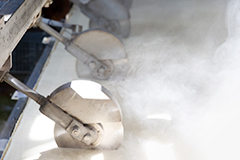
Cutting process of raw cotton tofu at Misuzu Corporation. Traditional techniques are used throughout important processes such as the production of soy milk and molding of tofu, which are the core of product manufacturing.
Frozen tofu is also called "Frozen tofu" or "Koya tofu", but after the war, the Frozen Tofu Union called "Koori Tofu" as a unified name, and now JAS is officially known as "Frozen tofu".
Frozen tofu made slowly using traditional natural methods

"Sennen Tofu" Kobayashi Tofu Workshop
Kobayashi Tetsuro and Thousand Year
From January to February, the coldest of the year, in the Shiraide district of Chino City, the hottest season for the production of frozen tofu, a specialty. In the 1960s, there were ten tofu shops in the area, and in the winter, it was a tradition that attracted people from Hokkaido to work, but now only one of the old-fashioned homemade tofu makes natural frozen tofu. Only Kobayashi Tofu Studio, which has the name "Sennen Tofu".
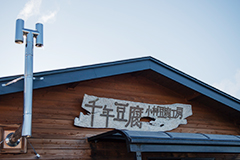
"Tofu freezes below -5°C. On sunny days, in anticipation of radiant cooling the next morning, we line up the tofu and freeze them all at once after the sun sets," says Kobayashi Tetsuro, the owner who is responsible for making tofu. The morning temperature on the day of the interview was minus 11℃. "It's the coldest time of the year and we've made the best frozen tofu," he says with a smile.
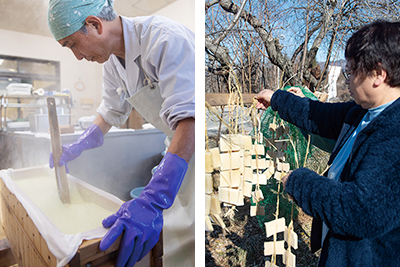
The method for making cotton tofu for frozen tofu is different from usual, and the key is to mix it after adding natural nigari to the soy milk. Regular cotton tofu is carefully mixed, then turned into fluffy, slurping tofu and harden in a wooden box, but for frozen tofu, mix thoroughly to make soy milk that has been removed from the chunks.こうすることで、より硬く締まった豆腐ができ、凍り豆腐になった時に大豆の力強い味わいを感じさせながらも、なめらかな口当たりが実現するのです。 After freezing the tofu to the core overnight, the baton was passed on to my wife Chitoshi for the next day. We knit a few frozen tofu with straw and make a continuous stream. It seems that Mikuen taught her aunt this ancient knitting technique. After hanging the continuous tofu made in this way outdoors, and repeat the freeze-drying process with clean air and warm daytime sunlight for about 2-3 weeks, the natural frozen tofu is complete. This work is usually carried out until around February 10th, but this year, there are few days when it is exposed to extremely warm winters, and he says he can't wait for the cold, unique to Chino, which is cold.
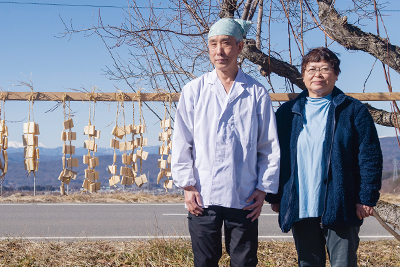
"Tofu is made with soybeans and soaked.TimesThe more you try, the more you end up worrying about, the more you try, the more you end up worrying about, such as how much water you boil, the temperature of the soy milk, the amount of crust, and when to add it, the more difficult and interesting it is," says Kobayashi. It was 12 years ago that Kobayashi, a chef, was particular about food safety and was committed to the food culture passed down in the region, and was taught the production method by Miken-san, a former tofu maker, to revive the traditional flavors.
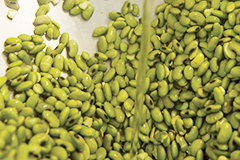
The soybeans used in "Sennen Tofu" are "Nakasennari" from Matsumoto and "Aobata", a very rare green soybean, which has been harvested in-house locally for 40 years and is produced by volunteers. While it is beautifully green and has a strong sweetness, it is difficult to cultivate and has a low yield, but Kobayashi is working hard to make tofu using "aobata" from the perspective of local production and consumption. We also use Ayamidori, a green soybean from Shiojiri.
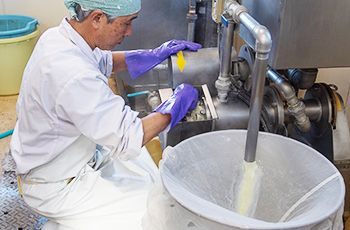
1. Soaking, grinding, heating, squeezing
The soybeans that have been soaked in water for over 18 hours are ground to make raw namago, and heated in a steam boiler to separate into soy milk and okara.

2. Coagulation
Add natural nigari to the tofu that has cooled to 73-75°C at once, and stir thoroughly with soy milk 120 times on a wooden board called kai.
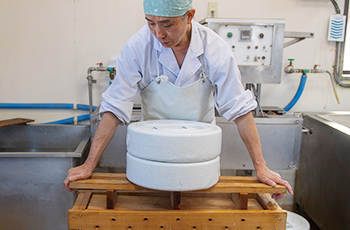
3. Molding, squeezing, molding
Cotton cloth is laid in a custom-made wooden frame mold box, pour soy milk into it, cover it, and apply pressure with a weight to remove moisture.
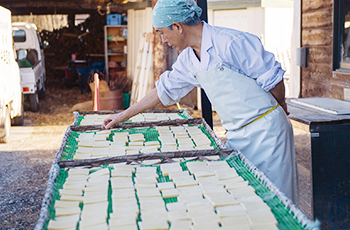
4. Molding, soaking in water, frozen
Once the tofu is in the form of tofu, remove it from the mold, expose it to groundwater, and remove the smelt. In the evening, cut it and arrange it outdoors, and freeze it all the way to the core without overhanging it against the snow.
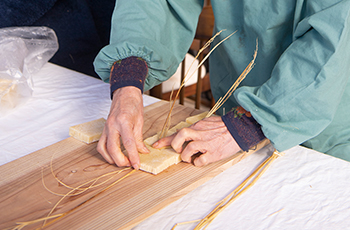
5. Lace up
The next day, we knit up frozen tofu with three straw pieces. Efficacy is truly a skilled technique, but it is said that in the past it was a job for children from each family.

6. Freeze-drying
Dry it under the eaves and other places to freeze, dissolve, and dry naturally, and then finish in 2-3 weeks. In the Shiraide area, peddlers once flourished, and it seems that they sold to Iida and Kofu.
["Thousand Year Tofu" Kobayashi Tofu Workshop]
260-1 Koto, Chino City TEL 0266-77-3102
http://sennentofu.jp/
Currently, frozen tofu (Koya tofu) is Nagano As one of the prefecture's representative traditional foods, it boasts a share of over 90% of the country. The manufacturer's Koya Tofu is made by using a method in which frozen tofu is left to rest at a low temperature for about 20 days, then aged, and then dried.
[Asahimatsu Foods] The largest manufacturer in the industry. "Shin Asahi Tofu" is a patented method that uses the baking soda, which was used to soften the tofu, to potassium carbonate, to switch to potassium carbonate, and while maintaining its plump and deliciousness, it achieves a significant reduction in salt equivalent to almost zero. "Let's extend our healthy life expectancy! Awards"Ministry of Health, Labour and WelfareHe was awarded the Director's Excellence Award. The soybeans used are also being switched to those that are international standards such as Global GAP and Asian GAP certified. At our business partner's bread shop, bread made with flour tofu, has also been expanded to have a wide range of uses, with bread winning in the health bread category at the world championships.
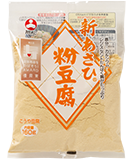
New Asahi Tofu
324 yen
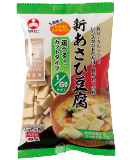
Asahi Tofu
1/60 size 162 yen
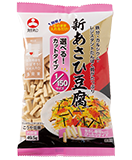
Asahi flour tofu
1/150 size 162 yen
[Shinano Yuki] Taking advantage of the strengths unique to small and medium-sized enterprises, we develop products that take time and effort. It uses the "fresh squeeze method" in the industry, in which domestic soybeans are finely ground, and the soybeans are separated into soy milk and okara before they are heated. By adding heat to soy milk only, the soy milk is used to add skewers to the bitterness and astringency found in soybean skin and germ, and although the yield is poor, it achieves kou and tofu, which has a rich soy milk and a strong soybean flavor. "Ren tofu" is a product that reminds you of the old-fashioned atmosphere and is also popular as a souvenir.
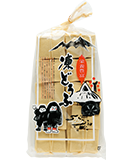
Less tofu
645 yen
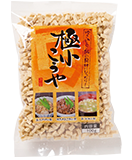
Ultra-small tofu
324 yen
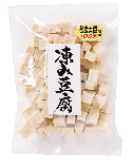
凍み豆腐さいの目
550 yen
[Tokiwa frozen food] By using soft well water made from underground water from the Central Alps, it has long been known to produce soft frozen tofu. Production volume is third in the industry. "Shinshu"Grown Soybean Koya Tofu" has a strong soybean flavor, and even frozen tofu can retain the sweetness and aroma of soybeans. Nagano Made with 100% Nakasennari from the prefecture, it is characterized by its chewy and smooth texture. Daigomaru, aged tofu cheese developed in collaboration with Yomeishu Manufacturing, using the technology of making frozen tofu, is also attracting attention.
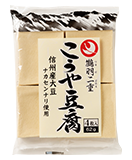
ShinshuProduced soybean ko and tofu
253 yen
[Misuzu Corporation] The "frozen processing method" using ammonia, which was invented in the early Showa era, brought innovative advances in all aspects of frozen tofu, including its taste, quality and productivity. Although it has also been patented, it is for the sake of the entire industry. Nagano The manufacturing method will be disclosed to manufacturers in the prefecture for free, Nagano This was the catalyst for the spread of frozen tofu from the prefecture throughout the country. Later, a method of using baking soda was born, and it has now become the mainstream. As a pioneer in the industry, he is also active in proposing uses and recipes that are not bound by traditional concepts, and also developing products. One of these is "Easy! Powder Tofu." It comes with dried vegetables and seasonings, and can be cooked using just hot water and a frying pan. Ginza NAGANO This item is available for sale only online.
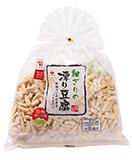
Thin Frozen Tofu
324 yen
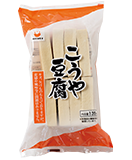
Koya tofu for the best
246 yen
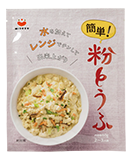
easy! Powder tofu
216 yen
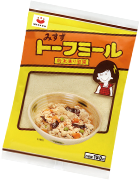
The original of powdered tofu!? What is "tofu meal"?
Frozen tofu is highly nutritious and is something you would want to actively consume as a healthy ingredient, but when you cook it, it tends to turn into stews or soups. Meanwhile, flour tofu is becoming popular because it is a powdered powder and can be used as a substitute for flour or bread crumbs, and can be used in a variety of dishes. There is also a theory that Misuzu Corporation was the first to commercialize it. We asked about its roots.
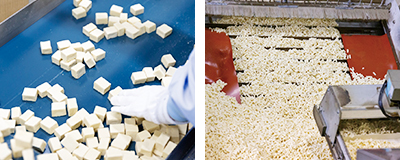
"Not only in our company, but in each manufacturer, we also managed to separate products that failed to mold and flour that was produced when cutting, which are also available for cheap to eat. This was popular because it was "can be used for a variety of purposes," "it's easy to cook and delicious," and "it's especially easy to make when roasted tofu, giving it a texture similar to fine raw tofu," so in the 1960s, we commercialized it as a tofu meal. Powdered tofu has become popular all over the country recently, but it has long been popular among the prefecture's residents as a home-like flavour."
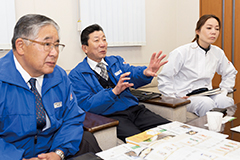
Wazawa Masafumi, Deputy General Manager of the Division
Takeuchi Takumi, Head of Marketing Department
Imai Mariko, Deputy Director of Quality Development Department
This article is information as of February 2020.
Please note that the products we carry may have changed.















